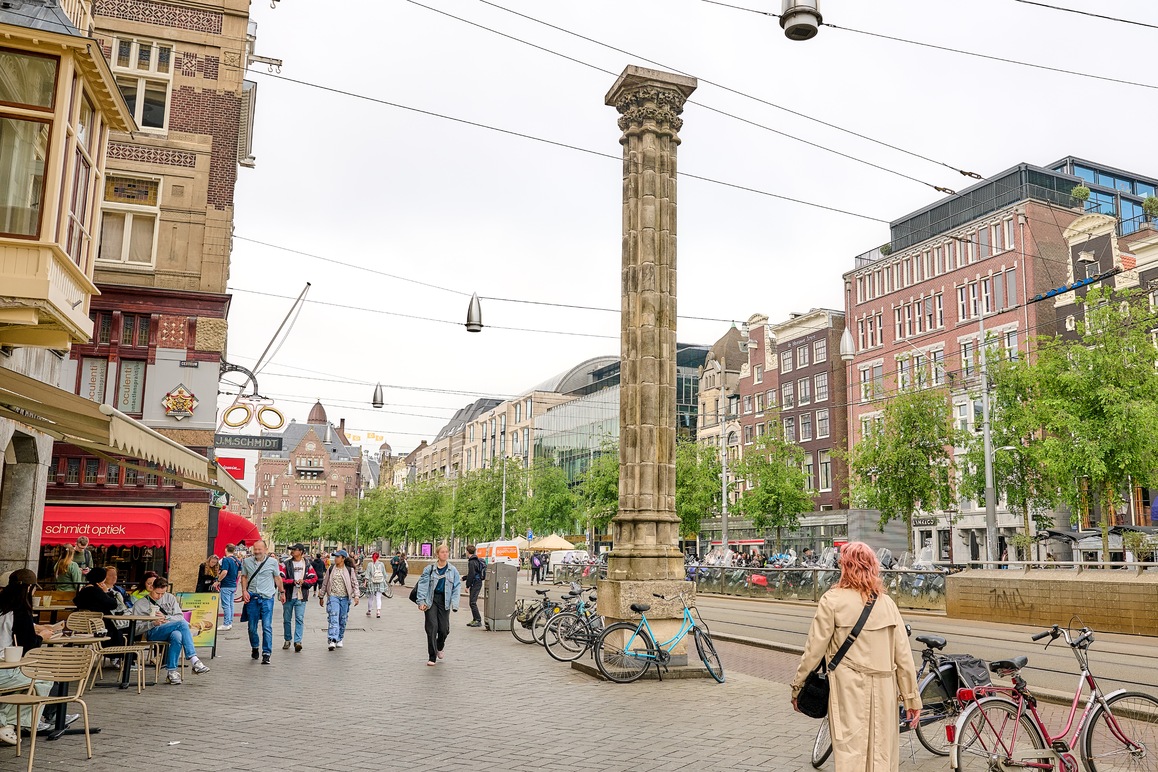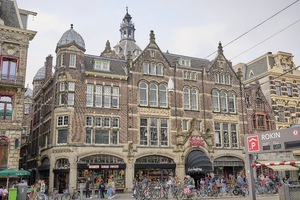On a winter night in 2017, another miracle takes place in Amsterdam; the Miracle Column has returned to the city centre! It stands there again, very familiar and now firmly anchored, like an exclamation mark on the spot where a long, long time ago, miracle took place.
Location
Kapel ter Heilige Stede
Kalverstraat 87
Type
Chapel
Religious community
Roman Catholic Church
Object
Miracle column on the Rokin
Maker and date
Hans 't Mannetje
1988
Visit
Miracle column is on the Rokin.
A chapel was quickly built on the spot where the Miracle of Amsterdam took place: the Heilige Stede. After the first chapel was completely destroyed by the great city fire of 1452, a large Gothic church is built on that spot. After the Alteratie in 1578, the now renamed Nieuwezijds Kapel comes into the hands of the Reformed Church in 1580. The maintenance too. In 1890, the church closes its doors due to dilapidation. The Catholics - who started a revival at the end of the nineteenth century - and the Protestants are at each other's throats. The Reformed Church wants to demolish the church and thus stop the advance of the Catholics; those same Catholics want to preserve their Heilige Stede for eternity. Unfortunately, they loose. In 1908, the church is demolished.
Alteratie
In 1578, the Catholic city government of Amsterdam was deposed. A Protestant city council took its place. The consequence of this change (Alteratie in Dutch) was that, from that moment on, the Reformed Church became the only church that was allowed to manifest itself publicly. Catholic churches and monasteries were confiscated and given new functions.
Heilige Stede
Literally ''holy place''. It refers to the location on Kalverstraat where the Miracle of Amsterdam took place in 1345. After the Protestant takeover in 1578, this church was also called Nieuwezijds Kapel. The original church that stood at this location was demolished in 1908 and was replaced by a new church building also called the Nieuwezijds Kapel.
Miracle of Amsterdam
The Miracle of Amsterdam took place in 1345 in a house on Kalverstraat. After a dying man could not keep down his last Holy Communion, a maid threw the vomit with the Blessed Host into the fireplace. The Host was found intact in the fireplace the next day. They concluded that God was present here in a special way and that He wanted to be worshipped in the Blessed Host at this location. Shortly afterwards, they built a pilgrimage chapel at the same location, which was called the Heilige Stede (Holy Place). This chapel was demolished in 1908.
Fragments
The City Council wants to preserve the sculpted building fragments of the chapel for reuse. The fragments are loaned to the Rijksmuseum by the Dutch Reformed Church. Until 1914, six shortened columns are placed in the garden. After many wanderings, the fragments are moved to the site of the former Uilenburg Synagogue in 1953, after the war. The fragments are left to their fate and partly wander around the city. In 1984, only 529 are counted. Four years later, they accidentally end up in trade and are spotted on the Spiegelgracht and at Christie's in an auction of garden furniture, among other places. A trestle statue of a 'milkmaid' and wall posts in the shape of men's heads end up in the Rijksmuseum. These objects are now in the collection of the Amsterdam Museum.
The Miracle Column
At the end of the 1980s, a column was erected on the Rokin at the initiative of the Stichting Amsterdam Versierd, a forerunner of the Stichting Vrienden van de Amsterdamse Binnenstad. Contrary to what is often claimed, it did not come entirely from the Heilige Stede. Sculptor Hans 't Mannetje built a new one from many fragments, and where better to place such a monument than at the place where the history of this 'Miracle Column' was written? After the column was temporarily stored elsewhere due to the construction of the North/South line, it was finally replaced on the Rokin in 2017.
Suzette van 't Hof
Staff member Collection, Information, Research and Publication Amsterdam Museum
Last edited
July 30, 2025
Miracle column Rokin, Hans 't Mannetje, stone building fragments, dimensions unknown. Photography Robert Westera.
Online sources
De mirakelkolom komt thuis
Last visited 10-03-2025
diverse bijdragen over de mirakelkolom
Last visited 10-03-2025






